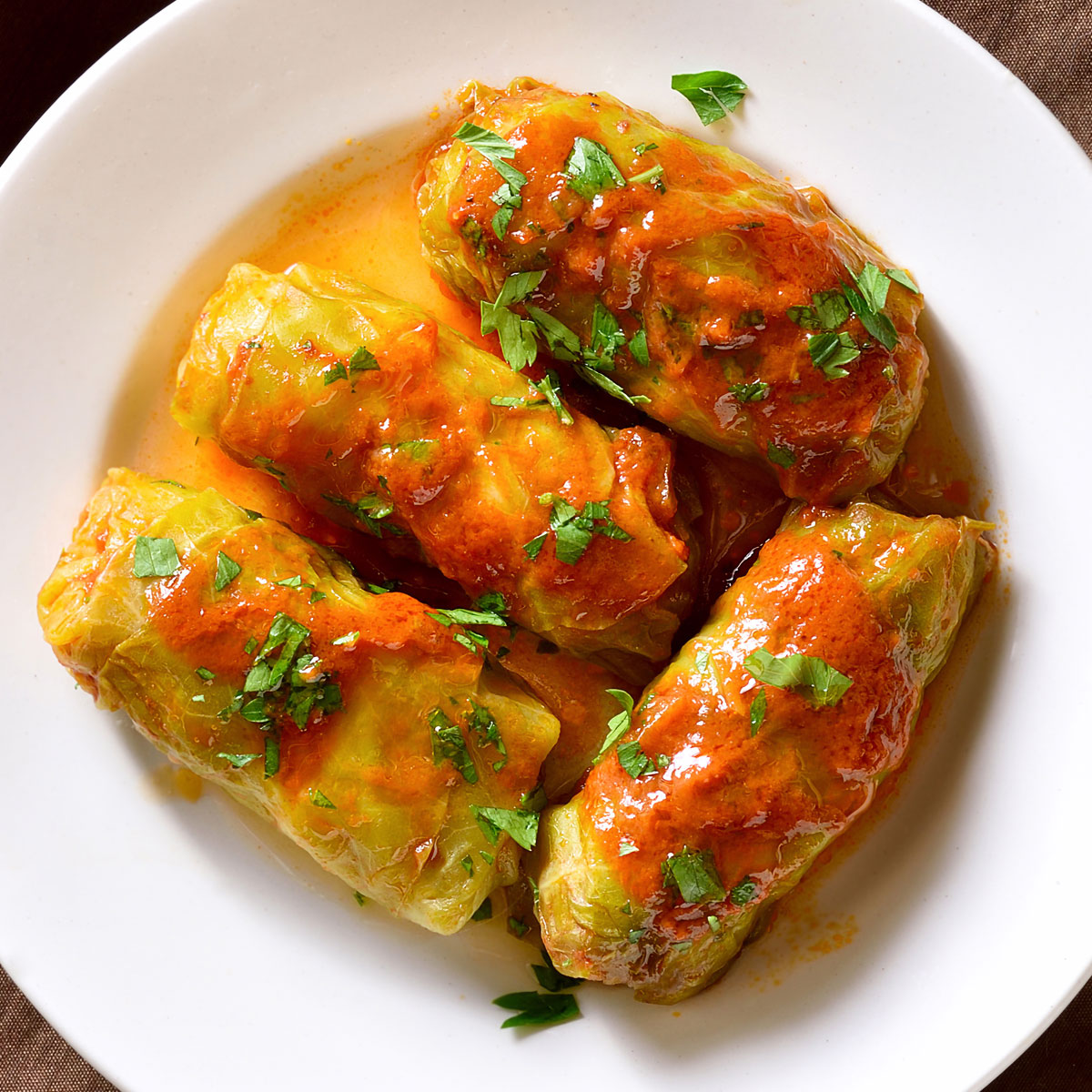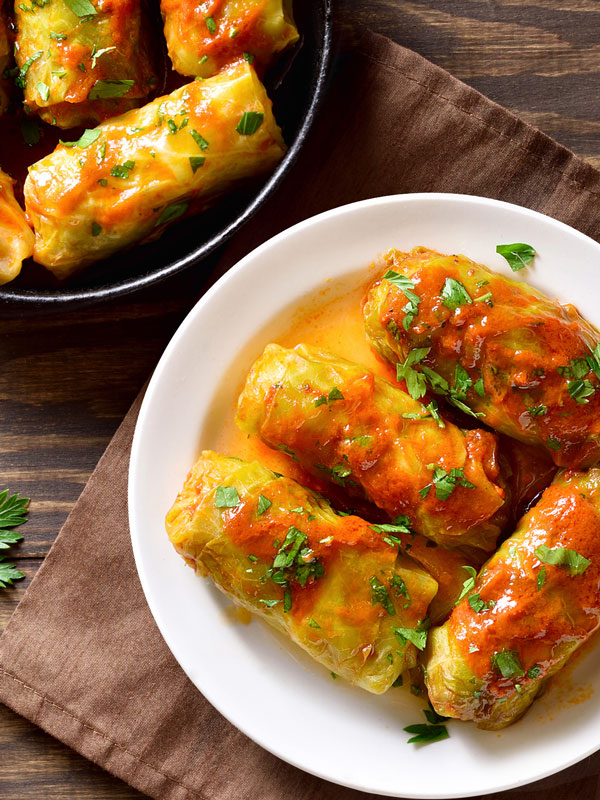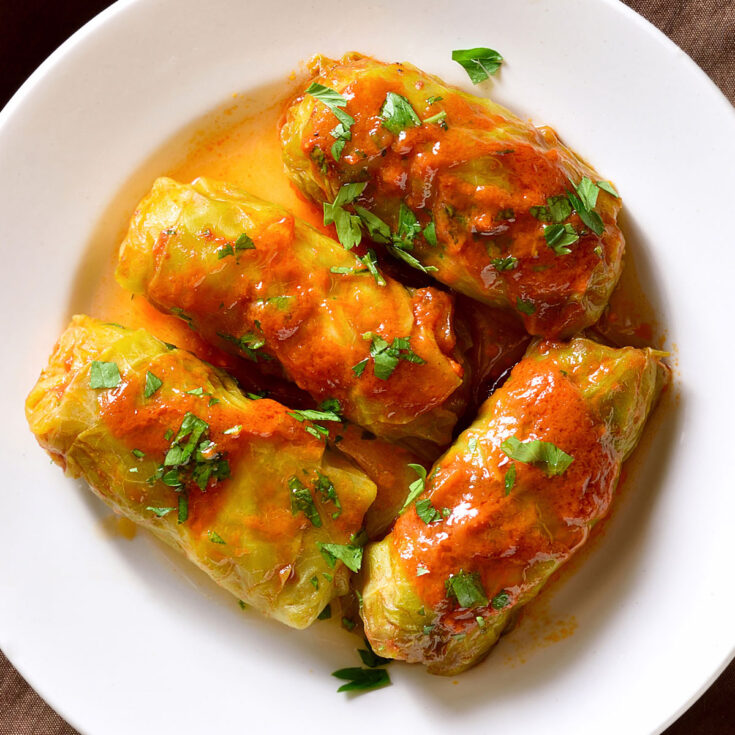Gołąbki z Ryżem i Mięsem, w Sosie Pomidorowym
Gołąbki: Polish Stuffed Cabbage Rolls with Tomato Sauce
How to pronounce it?
go-whomp-kee
‘Play’ to hear:

Gołąbki (literally: little doves, already plural) are Polish-style cabbage rolls, stuffed with a variety of fillings.
In this recipe, we’re stuffing our Gołąbki with a very classic filling: a mix of ground pork and rice. Rich tomato sauce compliments them beautifully, but you can enjoy them on their own.
For the full list of ingredients & detailed instructions, please see the recipe card at the end of this post. But before you scroll, there’s important stuff to know below.
To learn more about these Polish Cabbage Rolls and their history, check out this Gołąbki article at Culture.pl.
Do you need any special ingredients to make these Gołąbki?
This recipe couldn’t be simpler, there are no special ingredients required.
White Cabbage is a traditional choice, but you can use Savoy or Red Cabbage instead.
What could you serve with Stuffed Cabbage Rolls?
Stuffed Cabbage Rolls are one of those filling dishes that are typically enjoyed on their own, sometimes with fresh bread on the side.
For a more elaborate meal, serve them with mashed potatoes, dill pickles or some braised beet salad.
Can you make Gołąbki another way?
Yes, you can bake them instead – bake for one hour, covered, at 360°F (180°C).
‘Gołąbki’ can be cooked in a slow cooker / crock-pot. Sadly, I haven’t tried this method yet, therefore I cannot recommend a specific recipe.
Feel free to experiment with different fillings and sauces. Try swapping pork for a different type of meat, such as beef, poultry (chicken, turkey, duck…), veal, game meat…
You could also swap rice for barley, pearl barley, millet or buckwheat.
What diets are these Polish Stuffed Cabbage Rolls suitable for?
When making tomato sauce, swap all-purpose flour for grain-free flour (potato starch works well). This way, this recipe becomes gluten-free.
How long can you keep these Gołąbki in the fridge?
Once these Cabbage Rolls are served, ideally you should consume them within 4 hours.
To store them, allow any leftovers to cool. Refrigerate them in a container with a lid. You can keep Gołąbki chillin’ in the fridge for up to 3 days.
Can I freeze these Stuffed Cabbage Rolls?
Yes, you can:
- Wrap each cooked Cabbage Roll in aluminium foil (individually)
- Pour the sauce into a separate container with a lid, label it and place in the freezer.
Alternatively – freeze ‘Gołąbki’ and the sauce together, in a single container. Place the dish in a freezer-friendly container with a lid and label it well with a date and a description.
In any case, aim to consume them within 3 months.
How do I reheat these Gołąbki?
Avoid thawing Cabbage Rolls at room temperature. I find that they tend to fall apart during cooking because of it. But it’s worth moving them to the fridge for an hour before reheating (so they’re not so stone-cold).
In a microwave: If you have kept the Cabbage Rolls in a container that’s microwave-friendly, there’s no need to move them. Otherwise, place ‘Gołąbki’ in a bowl, half submerged in sauce (or water if you don’t have the sauce anymore).
Cover with a lid or another plate and microwave for around 3-5 minutes (from chilled) or 7-8 minutes (from frozen) until piping hot. The exact cooking time will depend on how many rolls you’re reheating. More rolls equal more time.
On the stove (frying pan or a cooking pot): This method works best for ‘Gołąbki’ stored in sauce. Pour a few drops of oil into the bottom of the pan (or pot) or melt a little bit of clarified butter (ghee). That way, the dish won’t burn. Reheat on a ‘low’ heat, covered, periodically checking if they’re not sticking. Cook until warm throughout, for anywhere between 8 to 15 minutes.
In the oven: Place the Cabbage Rolls in an oven-proof dish, cover with tomato sauce and cover with a lid. Bake at 300°F (150°C) for 12-15 minutes (from chilled) up to 20-25 minutes (from frozen). If you want the Rolls to get a bit crispy, remove the lid for the last few minutes of baking.
If you’ve stored ‘Gołąbki’ wrapped individually in aluminum foil, there’s no need to unwrap them. Just place them directly in the oven (times & temperature as above). Reheat the sauce in the microwave or on the stove.

Classic Gołąbki: Polish Stuffed Cabbage Rolls with Tomato Sauce (Pork & Rice)

Ingredients
For Stuffed Cabbage Rolls:
- 1 head white cabbage (3-3.3 lb, 1.3-1.5 kg) or savoy cabbage
- 1.7 lb (800 g) ground pork (e.g. pork shoulder)
- 1 large onion (7 oz, 200 g), yellow or white
- 2 tbsp neutral oil, e.g. canola
- 3 garlic cloves
- ½ cup (100 g) cooked rice - cooked ‘al dente’; that’s roughly 1.2 oz/33 g of uncooked rice
- 1 tbsp dried marjoram
- 1 qt (1 litre) chicken stock
- Salt, to season
- Ground black pepper, to season
- Handful of chopped dill or parsley, to garnish (optional)
For Tomato Sauce:
- ⅓ stick (30 g) butter
- 1 tbsp all-purpose flour
- 1 cup (250 ml) stock - remaining from cooking Gołąbki / Gołąbki juices; or meat stock
- 2 cups (500 g) tomato passata / purée
- 1 tbsp tomato paste / concentrate
- A pinch of sugar
- Salt, to season
- Ground black pepper, to season
Instructions
For Stuffed Cabbage Rolls:
- Wash the cabbage under running water. Even though the inside is usually clean (the outer leaves protect the inside), you might want to clean it anyway. Remove the tough outer leaves and discard them. Separate the inner leaves and wash them under running water.
- Cut out the stalk from the head.
- Grab a large cooking pot, large enough for the whole cabbage head to fit. Pour water in and bring it to boil. Add a solid pinch of salt and sugar and stir.
- Blanch the cabbage head in the boiling water, core side down. After a few minutes (2-3), the leaves should peel off easily. If not - cook it for a few more minutes.
- Remove cabbage to a baking tray, but keep the water in the pot.
- (Optional) To keep a more vibrant colour, you can place the leaves into ice water - that will slow down the cooking process.
- Set ten best leaves (largest, unbroken) aside. Using a paring knife, cut the main ‘vein’ out from each cabbage leaf and trim from the bottom with a knife.
- Peel an onion and dice it finely. Finely chop the garlic with a knife.
- Heat up a tablespoon or two of oil, add in chopped onion. When it turns golden, add chopped garlic and fry for another 1-2 minutes. Set aside to cool.
- In a large bowl, combine the ground meat, cooked rice, a tablespoon marjoram, and cooled down onion/garlic.
- Season with salt and pepper, mix thoroughly - no special tools are necessary, you can use your hands. This mass will be our stuffing.
- Lay the cabbage leaf flat. Place about ¼-⅓ cup of meat mixture in the centre of a cabbage leaf. Gather the edges of the cabbage inwards and roll it tightly. Continue until you have 10 decent-sized rolls.
- Line the bottom of the large cooking pot with some of the remaining pre-cooked leaves - this prevents the dish from burning.
- Place the cabbage rolls in the pot, in layers, one on top of another. Cover with a layer of remaining leaves.
- Pour the stock in. Cook on a medium heat, covered for about 40-50 minutes until the cabbage is tender. Not every cabbage is the same, you’ll have to check how soft it is as you go.
- When the cabbage rolls are nearly done, let’s make the tomato sauce.
For Tomato Sauce:
- Melt the butter in a saucepan. When melted, add in the flour. Whisk together and cook for a bit until it gains some colour.
- Pour in around a cup (250 ml) of the stock that got made from cooking the cabbage rolls. Bring to a boil, then reduce the heat.
- Pour in 2 cups of tomato passata/purée and add a tablespoon of tomato paste. Bring to a boil yet again, then reduce the heat to a minimum.
- Season with salt and ground pepper. If the tomatoes are too acidic, add a pinch of sugar to balance the flavours.
- Continue cooking until you reach a desired thickness.
Serving:
- Serve cooked cabbage rolls, with tomato sauce on top or on the side.
- Garnish with some freshly chopped dill or parsley leaves.
Notes
- Sometimes the filling ends up a bit dry, especially when the meat we used was too lean. If that’s the case, it’s worth adding an egg to the mass.
- I've adapted this recipe from Jakub Kuroń's Gołąbki recipe (in Polish)
Nutrition Information:
Yield:
5Serving Size:
2Amount Per Serving: Calories: 312Total Fat: 14gSaturated Fat: 3gTrans Fat: 0gUnsaturated Fat: 10gCholesterol: 49mgSodium: 449mgCarbohydrates: 28gFiber: 2gSugar: 9gProtein: 19g
Polonist is reader-supported. When you buy through links on our site, we may earn a small affiliate commission. Learn more
Recipe Information
Filed under:
Alternative traditional/regional names:
Also known / Misspelt internationally as:
Polish Cabbage Rolls, Polish Pigs in a Blanket, old fashioned Polish Stuffed Cabbage, Golabki, Golobki, Golombki, Golumpki, Gwumpki, Gwumpkies, Galumpkis, Golumkies, Golumpkies, Golumpkis, Gluntkes, Glubkis, Holubce, Halupki, Holubky, Holipshes, Goleptzi golumpki, Holishkes, Holep
Tested by:
First published on:
Recipe by / Adapted from:
Story by:
Bibliography / References: